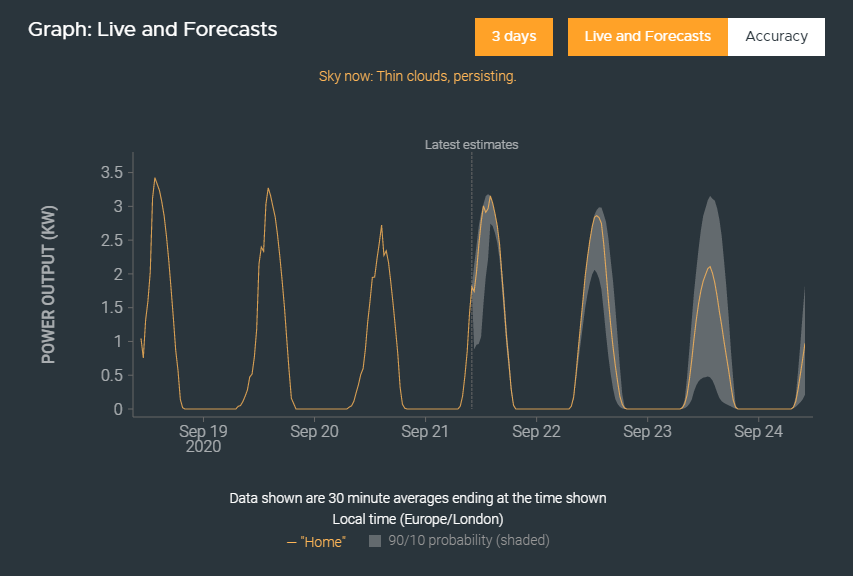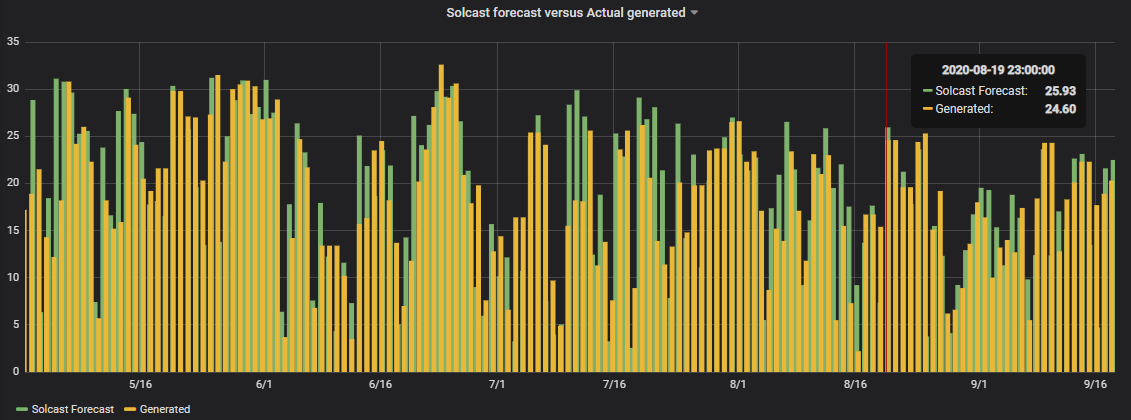Forecasting Solar generation using Solcast
As mentioned in my battery storage blogs, I think forecasting is going to become a big thing for energy usage and also saving energy.
If you know a bunch of important metrics ahead of time you can make smart decisions. The metrics in question could be Carbon intensity of the grid, solar generation, wind speeds, home usage patterns, variable energy prices etc etc.
As the UK energy grid becomes more reliant on renewable energy we will continue to be dictated to somewhat by the weather.
When the wind blows and the sun shines we find there is an abundance of generated energy on the grid. This usually means the wholesale price of that energy is cheaper. And when there is little sun and wind, the wholesale price of the energy is usually higher as well as grid carbon intensity. This is the basic premise of Octopus Energy Agile tariff.
Research engineer Jack Kelly is doing tireless work in the Solar forecasting space at a National Grid level. If you want to read about what he is up to, then take a look on his website or follow him on Twitter.
So how can we use some of the metrics mentioned above in a home setting?
I’m going to talk about one metric that feels important to my set-up; Solar Forecasting.
If you’ve read my other blog entries you’ll know that I have got a 17 panel solar installation, a small amount of batteries and a myenergi Zappi EV charger that can send excess solar generation to the EV.
So it is very useful for me to know how much solar I’m going to generate in the coming days.
If the forecast is good, I don’t have to worry too much. The sun covers home use, fills the batteries and on very sunny days means there is some left over to go in to the EV.
But it’s those not so good days where I can start to make decisions.
- Do I charge the batteries overnight to cover normal house usage the day? ie. import at cheaper overnight Agile pricing.
- Do I charge the EV overnight knowing there is no immediate solar to rely on?
- Do I NOT discharge my batteries overnight, so I save the charge for the next day?
In winter, when I might only be generating say 4kWh in the whole day, it is an easy decision to charge the batteries cheaply overnight to cover the next day.
But I find its those borderline days when there is probably just enough to cover home usage but maybe not enough to fill the batteries.
Hopefully you get the idea that being able to plan ahead a little could be useful?
Solcast Forecasting
In April 2020 I stumbled across Solcast, a website from an Australian team that provide a whole host of solar forecasting services.
One of the services offered being free Rooftop Solar Forecasts for home users.
Solcast gathers the latest satellite imagery from five weather satellites in order to model and forecast PV power generation across the planet. Every 5-15 minutes we detect the latest cloud cover conditions nearby your rooftop power generation site(s), and run sophisticated prediction algorithms to anticipate where the cloud cover will move next. Using PV power modelling tools, we convert the predictions of local cloud cover into forecasts of power output from each Rooftop PV system registered in our API Toolkit.
I signed up and quickly added my details. The free tier allows forecasting of a single set of panels that all face the same way and are on the same tilt angle. My solar system has 4 different aspects, but I was quickly able to come up with a pseudo single array set up that closely matched what I have got.
Over the next 6 months I recorded both the Solcast forecast and my own systems actual generation.
Here are the results.

You can see that right out of the box, even with a pseudo single panel setup (that doesn’t wholly match what I’ve really got), the forecast compared to actual generation are really good. Good to the point where I do now rely on them and use the forecast to make decisions.
In the graph above I just used the daily totals, but Solcast do also provide the forecast data in 30 minute slots for more granular usage.
They also provide summary graphs on their site once you login as shown below.

Solcast PV Tuning Technology
The yellow and green graph I posted above with the daily totals was created using standard out of the box Solcast forecasting data. But if you want to help Solcast create better forecasts you can send them your generation data. They then use your data to tune their data using what they call PV Tuning Technology.
This should result in more accurate forecasting of your home as it learns about your generation from your data.
Solar installations are complicated – they are often split amongst several arrays which are impacted by variations in topography, orientation, shade, dirt and degradation. Solcast’s tuning technology takes these factors, plus power output, solar irradiance and weather data, to learn the real characteristics of your PV plant.
Better forecasts are possible with tuning because it:
Captures the impacts of shading on your system, including vegetation, topography and surrounding infrastructure
Detects the orientation of your PV system (azimuth and tilt angles)
Senses the degradation of your PV system and assigns it a loss factor
Individualises the way your PV system responds to cloud cover
Uses these learned parameters to provide you with an improved solar forecast specific to that asset
Things I plan to do next with Solcast:
- Send my actual generation data back to Solcast to help improve my forecasting.
- I also intend looking at putting my solar installation into Solcast properly with its 4 different roofs at different angles with one roof pointing a different direction.
I will hopefully update this blog at some stage down the line when I have a sizeable dataset to present.
How do you set all this up?
First off, log on to Solcast and create and account.
From there, add your own rooftop.

As you can see, there is minimal information required to set up you system and start forecasting.
How do use and display the forecast data?
To display forecasting, I just set it up over on Home Assistant. This just pulled the daily forecast from Solcast into my Home Assistant dashboard.
But for the PV Tuning, I am going to use this article from the Node Red forum as a guide.
I just need to learn a bit of Node Red.
If you look at the above Node Red example you’ll see the guy has to pull the generation data from his inverter before sending up to Solcast. For me, I’d need to amend that code/flow as I use my emonPi / emonTX CT clamp based combo to monitor all my electricity ins and outs (solar, grid, battery, EV). So I’d need to get my generation data from the emonPi and send up to Solcast. But there is lots of help over on the open energy monitor forum around Node Red, so I’m hopeful of getting that to work.
You could also write your own code in your favourite programming language as the Solcast API documentation is quite comprehensive and there a few projects referenced on Github.
Finally, if all the above coding technobabble scares you, don’t worry. You can easily create a solar roof top entry in Solcast and just log onto their website each day to see your forecasts.
I hope you found this useful and perhaps inspirational for your next project?
As always, tag @energystatuk on Twitter with any comments or results from your own projects.
If you find this information useful and are thinking of joining Octopus Energy, please consider using my referral code or ‘buy me a coffee’ to help support running costs of the website.
Using this referral code will gift you £50 of free credit after signup: https://share.octopus.energy/linen-pearl-869
If you’re considering owning part of a wind farm through Ripple Energy, get £25 of free credit (if investing more than £1000) using my Ripple referral link.
We can also be found on Twitter, please follow us @energystatsuk for daily Agile tariff pricing graphs and summaries.
Also, be sure to check out our Dashboard, Download Historical Data and OctoChargeCalc features to help you decide whether these tariffs are the right fit for you.
Note: The past performance of energy pricing is not necessarily a guide to the future.
